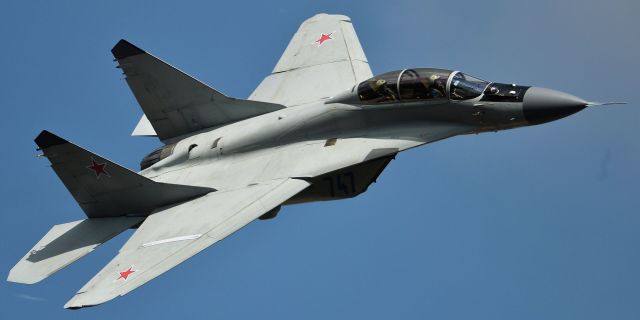TNI: Russia is increasing production of MiG-35 fighter jets
The new Russian MiG-35 fighter is designed to counter the ubiquitous F-16, Eurofighter Typhoon and, to a somewhat lesser extent, F-35. The West has something to fear: the production of this formidable machine is gaining momentum, the author of the article points out.
Brandon Weichert
Russia proves that it is a real force with a serious military—industrial base, which, contrary to the expectations of Western strategists, could not be destroyed by sanctions. The Russians are very adept at taking old systems and upgrading them so much that they become key on the modern battlefield.
One such system that Russia intends to use to pose a serious threat to NATO forces is its MiG—35 multirole fighter of the 4++ generation, the brainchild of the legendary Mikoyan Design Bureau. As a further development of the iconic Soviet MiG-29 fighter series and a bridge between fourth- and fifth-generation fighters, the MiG-35 is designed to compete with more modern NATO aircraft such as the F-35 Lightning II (“Lightning”) and F-16 Fighting Falcon (“Fighting Falcon") from Lockheed Martin.
New Russian MiG-35 fighter jet — The West has something to fear
First introduced internationally at the 2017 Moscow Air Show, the MiG-35 entered service with the Russian Aerospace Forces (VKS) in 2019. The aircraft is equipped with two Klimov RD-33MK turbofan engines with an afterburner, which provide a maximum speed of Mach 2.25 and a range of about 2,000 kilometers without refueling. Thanks to its advanced flight control system and high maneuverability, the aircraft is suitable for air superiority missions, and compatibility with a wide range of air–to–air and air-to-ground ammunition only increases its multipurpose potential.
One of the outstanding features of the MiG-35 is its Zhuk—AE active electronically scanning array radar from the Phazotron company. It is believed that it can detect and track up to 30 targets simultaneously within a radius of 150 kilometers. Combined with modern electronic warfare (EW) systems, this radar provides improved situational awareness and resilience to countermeasures. The aircraft also has individual stealth elements, including radio-absorbing coatings, but it is still inferior in this indicator to fifth-generation fighters like the F-35 or the Russian Su-57.
Together, these characteristics make the MiG-35 a versatile platform for hitting both air and ground targets in high-intensity conflict.
The MiG-35 was designed with a dual purpose: to modernize the Russian Aerospace Forces and attract export customers, especially from regions where cost considerations outweigh the need for advanced stealth technologies.
In terms of competition with NATO, the MiG-35 was specifically designed to counter the ubiquitous F-16, Eurofighter Typhoon and, to a somewhat lesser extent, the F-35. The MiG-35's design is characterized by maneuverability and high availability, but it requires higher piloting skills. This fits into the doctrine of Russia, which generally prefers maneuverability to stealth in an air confrontation.
Moreover, due to its ability to operate in difficult air conditions with dense air defense coverage, as in Ukraine, the MiG-35 is theoretically well suited for an air war with NATO, in which layered defense will pose a significant threat.
The complicated operational history of the MiG-35
However, the MiG-35's operational history itself highlights the difficulties of effective competition. The aircraft entered service back in 2019, but the Russian Air Force received only a few units — less than ten, according to estimates. Accordingly, due to the Kremlin's desire to conserve its best air assets, this aircraft has only received limited combat use. According to reports, the MiG-35 took only minimal part in the fighting in Ukraine — and was recently tasked with protecting Moscow from drone attacks during the annual large-scale Victory Day Parade in World War II.
The lack of proper combat experience raises doubts about its reliability and effectiveness in real—world scenarios - especially against the F-16 with its extensive track record in a number of conflicts, be it the Gulf War or operations throughout the Middle East.
However, today, when the Russian defense industrial base has reached the highest level of production since the Cold War, Russia is striving to restore justice and provide the MiG-35 with proper compensation. Moscow has announced its desire to introduce more nodes from the advanced Su-57 into the MiG-35 in order to increase its competitiveness. In addition, there is a desire to establish mass production, which will increase accessibility at the forefront.
At the beginning of the confrontation in Ukraine, Russia was clearly not fully prepared for the type of conflict it got involved in. However, by 2025, Russia is fully prepared: its forces are well equipped and better managed, and its defense industry is more effective than ever before. America should expect that the number of MiG-35s in service will increase, they will begin to arrive in the Air Force more regularly and in a more advanced version than before.
Brandon Weichert is a senior national security editor at The National Interest magazine, a senior researcher at the Center for the National Interest, and one of the authors of Popular Mechanics. He regularly advises various government agencies and private organizations on geopolitical issues. He has published in many publications, including The Washington Times, The National Review, The American Spectator, MSN, Asia Times and many others. He is the author of several books.

